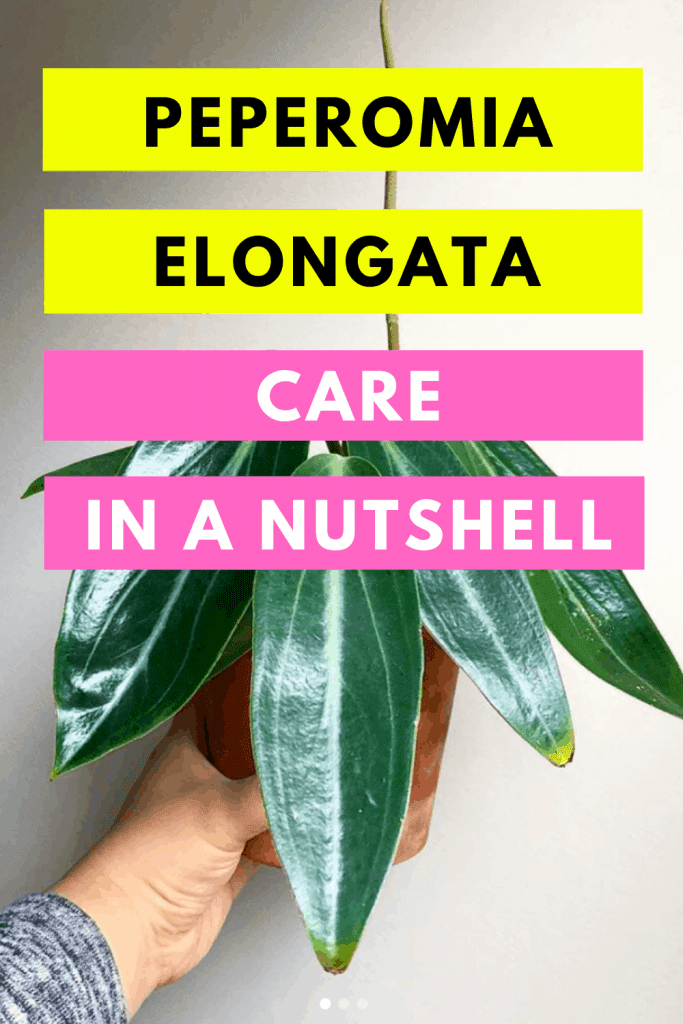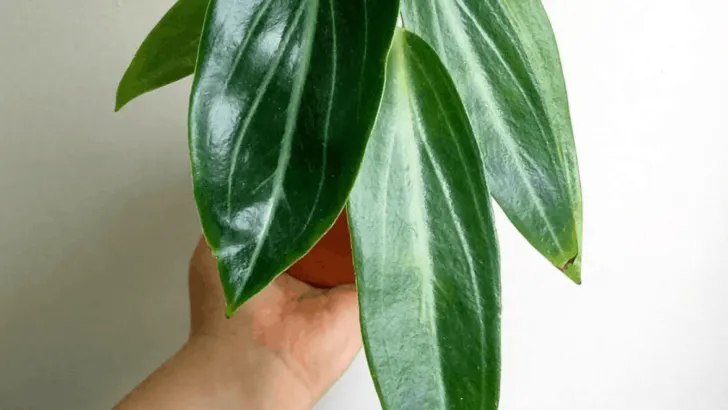The Peperomia Elongata is an evergreen perennial native to South America. It is semi-succulent and to me, it looks like a bigger version of the Philodendron green princess.
It has fleshy shoots and pale green leaves with light veins. In its natural habitat it is generally an epiphyte but also grows in soil.
This means that it starts from the soil but then trails up other jungle vegetation and feeds off of the organic material in tree bark and what it gathers from mist and rainfall.
Its succulent nature means it is very good at conserving water. It is a rare Peperomia in cultivation but has recently gained popularity because scientists started to research its potential anti-cancerous properties.
If you were thinking of acquiring a rare and interesting plant this one might be right for you.
Table of Contents

Peperomia Elongata Care Instructions
Soil
Because of their epiphytic nature, Peperomia Elongata will climb up trees and other plants just like orchids.
This is why I recommend the usual slightly acidic, well-draining epiphyte/aroid soil mix. This is one part orchid bark, one part perlite, and one part growers mix.
This will give the roots something to grab onto and will allow water to drain freely through.
You can tweak and add or change anything you want, the most important thing is that the mix is airy and well-draining and will not cause root rot or waterlogging as this is the most common problem with Peperomias in general.
Light
Peperomia Elongata like shade to partial shade which means avoid direct sunlight by all means and place it next to an east-facing window.
Morning direct light or occasional dappled sunlight should be fine, just make sure you are avoiding direct sunlight that will cause bleaching and burning of the leaves.
This is irreparable damage and you can only cut away the leaves for aesthetic reasons.
It will do well with 12 to 14 hours of artificial light also. Too little light will cause it too lose it’s color, wilt, and push out poor new growth.
Watering
The succulent nature of the Peperomia Elongata means that you don’t need to be as diligent with watering as with other plants.
You can allow the top 2 to 3 inches soil of your Peperomia Elongata to dry out between waterings.
I always recommend erring on the dry side and increasing the watering frequency if you notice the plant is under-watered, as the consequences of under-watering are more easily solvable than those of over-watering (fungus gnats and root rot).
If you notice the leaves are getting crinkled this usually means it is under-watered and you can increase the frequency a bit.
I like to water my Peperomias from the bottom and this is a good practice for the Peperomia Elongata too as it has semi-succulent leaves that can easily get damaged or attract pests and diseases if wet.
I do this by placing the plant with its nursery pot into a water container and leave it there for at least half an hour to an hour. Then let the plant drain fully and put it back where it was.
Temperature
Peperomia Elongata likes temperatures between 45 to 95 degrees F.
They should do well in most regular home temperatures but make sure it is not subjected to any sudden temperature changes or drafts.
Place it away from vents and radiators and further away from windows in the winter. Do not expose it to temperatures lower than 30F as this will surely kill the plant.
Humidity
As tropical plants, Peperomia Elongata like high humidity.
If you haven’t already I recommend purchasing a humidity meter so that you can adjust and control the humidity more easily and know the days when it drops and act accordingly.
A humidifier that keeps the humidity up to 60% in the room is the safest bet, alternatively you could try with regular very fine misting but don’t forget to provide ample air circulation in this case as droplets of water staying on the leaves for a long time attract fungal and bacterial diseases.
A humidity tray is an option, just place some pebbles in a tray and add some water in such a way that you can place your plant on top of the pebbles and it won’t touch the water.
This will allow the water to slowly evaporate around the plant, raise the humidity, and won’t cause root rot.
Fertilizer
Peperomia Elongata doesn’t require a lot of fertilizing. Less and more frequently is the way to go if you even choose to fertilize at all.
I recommend a liquid fertilizer diluted to one-fourth of its strength, added to the plant just after watering.
You could also opt for an organic fertilizer of your choice, just be careful not to overfeed.
Use half as much as you do for your other plants. This plant will survive perfectly well with one or two fertilizing episodes in a growing season and none during winter.
Propagation
Peperomia Elongata is easily propagated just like most succulents. The easiest and most common method is by vegetative cuttings in soil.
Pick a part of the plant that you will cut. It must be healthy and free of pests or fungus. You can cut away just a leaf with the petiole or include some stem for even better results.
Give the new cuttings an hour or two to heal the wound you make to cut it off and then gently place it into a rich soil medium.
Keep the soil moist while the plant is trying to put down roots and inspect it regularly for signs of rot.
In a few weeks, your Peperomia Elongata should already have a couple of inches of healthy roots, maybe even some new growth, and will be ready to be re-potted into its permanent home.
I like to prepare the pot in advance and pre-moisten the soil before transplanting.
Growth
It is a very slow grower so do not expect your Peperomia Elongata to get huge. I will reach up to 10 to 12 inches in height maximum and will not put out new growth frequently.
Potting
Since the Peperomia Elongata grows so slowly and Peperomias, in general, like to be a little bit root bound you are not in any rush to repot this plant.
They will do well in the same container for years.
If you do notice it getting severely root bound or the soil has become of poor quality (it is not absorbing water or it has started deteriorating), repot it into a slightly acidic potting mix just like the one mentioned in the soil section and into a pot that in an inch larger than the previous one.
Common Problems with Peperomia Elongata
Cercospora Leaf Spot
This is a common fungal issue on Peperomia plants. You will notice raised areas on the underside of the leaves.
It will look like oozy blisters with yellow, brown, and black color and yellow ring-like margins.
You should cut away any affected foliage, treat the plant with a store-bought fungicide, and provide a different environment for your plant to prevent the fungi from coming back and pestering your Peperomia.
Make sure it has more light, more air circulation, and a little less water than usual.
Virus Ringspot
This is the only viral disease affecting peperomias and it will manifest itself as necrotic brown lesions on the leaves of your Peperomia Elongata.The only thing to do is removing the plant as soon as possible and throwing it away.
There is no cure since it is a virus, and your main goal should be making sure the other plants don’t get infected too.
Clean all your tools regularly with alcohol always to prevent contaminating other plants.
Fungus Gnats
Since your Peperomia Elongata likes a warm and humid environment fungus gnats are always a potential problem.
They are tiny fly-like insects that can be seen running around on the soil of your plant. This is where they keep their larvae and where they feed on organic matter in the soil.
They are not a problem themselves but can make your plant more susceptible to bacteria fungi and viruses.
Chemical treatment usually doesn’t help but watering more rarely and increasing air circulation to keep the top layer of the soil drier will deter them.
Mealybugs
Mealybugs are a common pest for succulent and semi-succulent plants.
They are wooly looking insects that feed on the sap of the plant and you will most likely notice them around the stems and under the leaves as they like the softest parts of the plant. This makes new growth particularly vulnerable.
Luckily they are slow in movement and relatively easy to get rid of.
Firstly you should remove all of the ones you can see with the naked eye with q-tips dipped in alcohol.
Then you can shower the plant and do an insecticidal soap treatment to get rid of all the larvae and eggs.
This process could need to be repeated a few times to totally get rid of them but also including neem oil in this treatment as it deters new pests from feeding and it will make this process faster and more successful.
Tips to keep your Peperomia Elongata problem-free
- Be careful not to over-water, opt for less rather than more, and increase if needed
- Give it a well-draining slightly acidic soil
- Put it in a bright spot with indirect sunlight
- Increase humidity with a humidifier
- Treat it with regular neem oil treatments to deter pests and diseases
Frequently asked questions about Peperomia Elongata
Why is my Peperomia Elongata dropping leaves?
Dropping of leaves without any other sign of pests or over-watering is usually caused by low temperatures. The plant then goes into survival mode and drops leaves in order to stay alive in a hostile environment and conserve energy.
Try and move your Peperomia Elongata to a warmer spot in your home
Why are only the lower leaves of my Peperomia Elongata yellowing and wilting?
This is a sign of nitrogen deficiency. Try and increase the feeding schedule slightly and feed it small amounts of half-strength liquid fertilizer regularly.
The leaves cannot be saved and should be cut away, but the yellowing should stop appearing on the next ones that grow.
Can I propagate my Peperomia Elongata by water?
You can, but this leads to more problems when the new roots need to adapt to the soil. The transition from water to the soil will make the plant more susceptible to rotting and propagation in water will not yield roots any faster than soil propagation will.
There are white hard deposits on my Peperomia Elongata leaves, what is this?
This could be a consequence of watering and/or misting with hard water. The mineral deposits will come out of the leaves pores or settle on the leaves when sprayed on.
An easy fix is switching to distilled, rain, or aquarium water. You can also wipe the deposits away from the leaves with a cotton round with some water and alcohol, and it is mainly an aesthetic issue if the plant is not suffering from other consequences of hard water.
Conclusion
The Peperomia Elongata is a rare but beautiful tropical plant that not many people can get their hands on. The particular elongated leaves with bright elegant veining make the Peperomia Elongata stand out from other Peperomias.
Water it sparingly, feed it even more sparingly, and put it in a bright place to make sure your Peperomia has the best chance for success.
In my opinion, it would be a perfect addition for an office or kitchen, as it will stay medium-sized and will not need much pruning or hands-on care.
Do you own a Peperomia Elongata? Please share it with us in our Facebook group, we are always happy to see rare plants and share tips and tricks to keep out urban jungles thriving.


